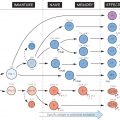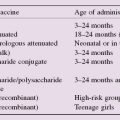At this point the reader will appreciate that the immune system is highly efficient at recognizing foreign substances by their shape but has no infallible way of distinguishing whether they are dangerous (‘pathogenic’). By and large, this approach works well to control infection, but it does have its unfortunate side, e.g. the violent immune response against foreign but harmless structures such as pollen grains, etc. (see Fig. 35).
Would-be parasitic microorganisms that penetrate the barriers of skin or mucous membranes (top) have to run the gauntlet of four main recognition systems: complement (top right), phagocytic cells (centre), antibody (right) and cell-mediated immunity (bottom), together with their often interacting effector mechanisms. Unless primed by previous contact with the appropriate antigen, antibody and cell-mediated (adaptive) responses do not come into action for several days, whereas complement and phagocytic cells (innate), being ever-present, act within minutes. There are also (top centre) specialized innate elements, such as lysozyme, interferons, etc., which act more or less non-specifically, much as antibiotics do. Innate molecules that have evolved to block virus infection are sometimes called restriction factors.
Generally speaking, complement and antibody are most active against microorganisms free in the blood or tissues, while cell-mediated responses are most active against those that seek refuge in cells (left). But which mechanism, if any, is actually effective depends largely on the tactics of the microorganism itself. Successful parasites are those able to evade, resist or inhibit the relevant immune mechanisms, as illustrated in the following five figures. Evasion molecules, together with those that directly damage the host, are known as virulence factors. With increased knowledge of the host and pathogen genomes, identification of virulence factors has become a top priority.
Entry
Many microorganisms enter the body through wounds or bites, but others live on the skin or mucous membranes of the intestine, respiratory tract, etc., and are thus technically outside the body.
Surface Barriers
Skin and mucous membranes are to some extent protected by acid pH, enzymes, mucus and other antimicrobial secretions, as well as IgA antibody (see below). The lungs, intestine, genitourinary tract and eye each have their own specialized combination of protection mechanisms.
Natural Antibiotics
The antibacterial enzyme lysozyme
Stay updated, free articles. Join our Telegram channel

Full access? Get Clinical Tree





